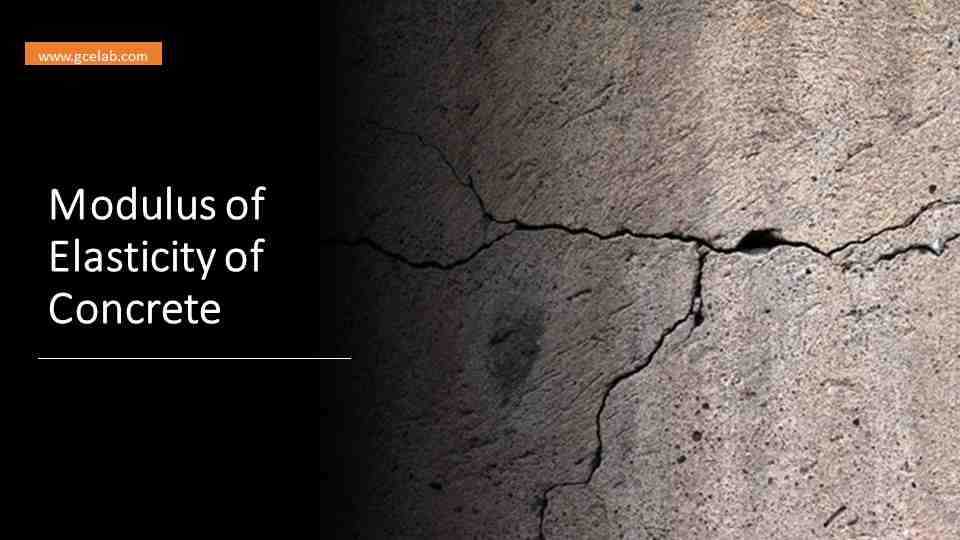What is the Modulus of Elasticity of Concrete? 9 Important Points
- By
- Pooja |
- October 03, 2021 |
- Civil Engineering, Bridge Engineering, Building/ Structure Engineering,

Table of Contents
What is the Elasticity of Concrete?
What is the Modulus of Concrete?
What is the Modulus of Elasticity of Concrete?
How to Calculate the Modulus of Elasticity of Concrete?
What are the Factors affecting the Modulus of Elasticity of Concrete?
Effect of Hydrated Cement Paste
What is the Dynamic Modulus of Elasticity?
How Modulus of Elasticity of Concrete can help to improve structure performance?
What is the Elasticity of Concrete?
At low-stress levels, concrete's elasticity remains essentially constant, but as matrix cracking occurs, it begins to decrease. Concrete has a poor coefficient of thermal extension or expansion, which means it decreases as it ages. Due to the shrinkage & strain, all concrete constructions will crack to a certain level.
This characteristic of concrete is known as the Elasticity of Concrete.
What is the Modulus of Concrete?
Hardened cement paste has an elastic modulus of 10 to 30 GPa, while aggregate has an elastic modulus of 45 to 85 GPa. The elastic modulus of concrete is usually between 30 and 50 GPa.
What is the Modulus of Elasticity of Concrete?
The stiffness of concrete is measured by its modulus of elasticity, which is an excellent indicator of strength. Concrete with a higher modulus of elasticity may withstand more stress before becoming brittle. “Concrete's elastic modulus ranges from 30 to 50 GPa in general. In recent years, design regulations have mandated concrete to have a minimum modulus of elasticity.
The goal is to prevent excessive distortion and wobble in tall structures. Starin and strain are inextricably linked. One thing leads to another. Strain can result from a variety of sources other than applied stress.
Creep and Shrinking Strains:
Under typical stress conditions, shrinkage and creep strain has the same magnitude as elastic strain. This is why, while calculating the deformation of a concrete member, all types of strain must be included.
Read More:
Why does Concrete need Reinforcement? 6 Important Points
What is the Function of Bridge Foundation or Pier and its Types? 5 Important Points
Pre-stressed Concrete, Pre-tensioning and Post-tensioning: 3 Important Points
How to Calculate the Modulus of Elasticity of Concrete?
The ratio of the applied stress to the corresponding strain is known as the concrete modulus of elasticity (Ec). It demonstrates not just concrete's ability to tolerate deformation owing to functional stress, but also to its stiffness. In simple words, it reflects concrete's elastic deflection ability.
The modulus of elasticity of concrete is affected by aggregate and mixture quantities.
What are the Factors affecting the Modulus of Elasticity of Concrete?
Because concrete is a multiphase solid, there is no direct relationship between density and modulus like there is in single-phase materials like metals. Porosity, density, constituent moduli of elasticity, mix proportion, and transition zone properties all influence the modulus. The elasticity of concrete is resolute by these characteristics.
Effect of Aggregates
Concrete with dense aggregate has a high E value. A higher quantity of coarse aggregate also results in a high E value. Note that a significant E value for the aggregate will result in an elastic incongruity in the transition area between the aggregate/ mortar, and their cracks.
Effect of Hydrated Cement Paste
The permeability of cement paste determines its elastic modulus. The permeability of cement paste is controlled by the water-cement ratio (w/c), additive dosage, air content, and degree of cement hydration. Concrete's modulus of elasticity can be signified as Ec = Eag + Ep(1-g)
Effect of the Transition Zone
The stress and strain behaviour is directly inclined by void space and microcracks. The transition area is weak due to the cracks in the area, the orientation of the C-H crystals, and the presence of void spaces. As a result, the elastic modulus decreases as the load increases.
What is the Dynamic Modulus of Elasticity?
Many academics have researched dynamic modulus, which is one of the most essential structural characteristics in road design. The dynamic modulus of a cold and recycled mix (at numerous temperatures and frequencies) determines its viscoelasticity. Cold and recycled mix asphalt (CRME) normally has less temperature & frequency dependence than HMA.
But they should still be categorised as thermo-viscoelastic materials. CRME, like standard HMA, may follow the time-temperature principle, however, CRME's viscoelasticity is weaker than HMA's. CRME's dynamic modulus.
Read More:
How to become a Structure Engineer? 8 Important Points
What is Non-destructive Testing? 10 important points
What is the purpose of Pile Cap Design? 13 Important Points
What is Structural Health Monitoring? 9 Important Points
Shrinkage of Concrete:
Shrinkage is a type of compressive deformation that occurs over time. The total shrinkage of concrete is determined by the ingredients of concrete, the size of the member, and the environmental conditions. However, for a specified humidity and temperature, the amount of water present in the concrete at the moment of mixing has the greatest impact on overall shrinkage.
The cement content, on the other hand, has a smaller impact on total concrete shrinkage. Creep is a type of time-dependent concrete deformation in which the material continues to deform over time, commonly under compressive force. When the stressors are released, the creep strains partially recover.
The elastic recovery is instantaneous, however, the creep recovery is gradual. To calculate the total deflection of the structure, the long-term deflection will be added to the short-term deflection. To account for the effect of creep, the long-term modulus Ece or effective modulus of concrete will be required.
Thermal Expansion of Concrete
Because concrete is prepared and used in a wide variety of temperatures in nations with extremely hot or cold climates, understanding its thermal expansion is critical. Furthermore, during a fire, concrete will have a significant temperature effect. The thermal expansion coefficient is determined by the kind of aggregate, cement, cement concentration, relative humidity, and section size.
How Modulus of Elasticity of Concrete can help to improve structure performance?
The modulus of elasticity (MOE) is a measure of a material's stiffness or resistance to deformation under stress. In the case of concrete, a higher MOE indicates a stronger and more rigid material. By understanding and utilizing the MOE of concrete, engineers and designers can improve the performance of structures in several ways:
-
Increasing Load Capacity: The MOE of concrete is directly related to its ability to withstand compressive and tensile stresses. By using concrete with a higher MOE, designers can increase the load capacity of a structure and ensure it can support heavier loads.
-
Reducing Deflection: Deflection is the bending or sagging of a structure under load. By using concrete with a higher MOE, designers can reduce the deflection of a structure and improve its overall stability and durability.
-
Enhancing Durability: Concrete structures are subjected to various environmental factors such as temperature changes, moisture, and chemical exposure. By using concrete with a higher MOE, engineers can create structures that are more resistant to these factors, thus improving their longevity and durability.
-
Improving Aesthetics: Concrete with a higher MOE can be molded and shaped more easily, allowing for more intricate and visually appealing designs.
Overall, by understanding and utilizing the MOE of concrete, engineers and designers can create more efficient and durable structures that can withstand various loads and environmental factors.
I hope the blog provides you with a good understanding of the Modulus of Elasticity of Concrete and its associated features.
Please feel free to like, share and comment.
Admin, gcelab.com
Please see our Pillar Post to know why we founded gcelab.com.

Pooja
Founder at gcelab.com, Pooja is an Entrepreneur unlocking human potential. Working in the Principles of Lean Start-up, Pooja believes in Transparency and User Happiness the most. Pooja’s background in teaching gives her a sophisticated grasp on even the most tedious aspect of course building. She is passionate about people who believe that good is not enough.



